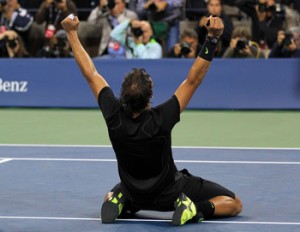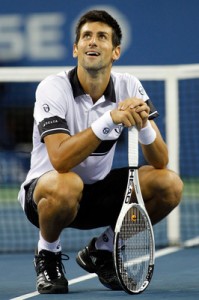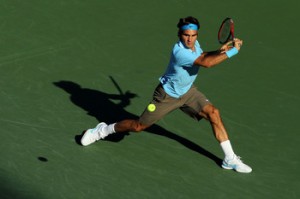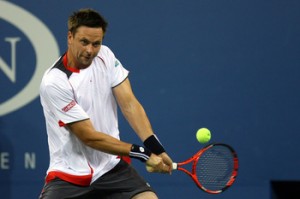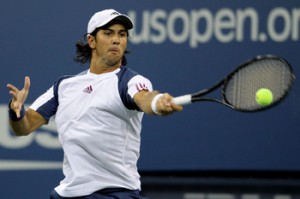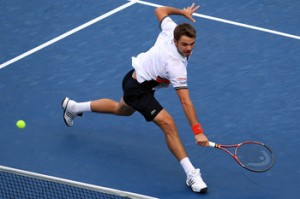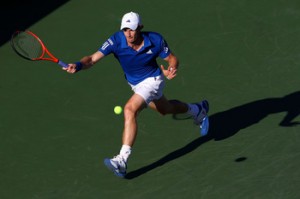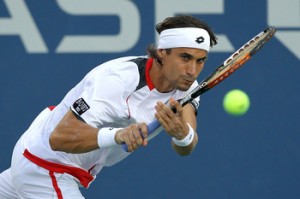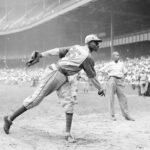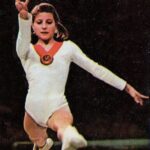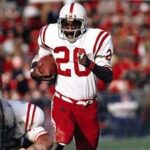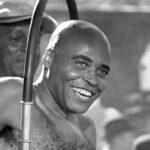Men’s Tennis Power Rankings: Rafael Nadal Soars Seeking World Tour Crown
It was the day after the Australian Open. Rafael Nadal had slipped, in the space of a fortnight, from No. 2 in the world to No. 4, and was almost 4,000 points off the Federer pace.
But you can’t afford to turn your back for a moment in this fast-changing game of tennis.
Take the last two months. Wimbledon—and the grass season with it—came to an end. The normal hiatus that follows the frenetic action between the clay Masters and London is usually a welcome oasis in the middle of the tennis year. But this year, there has barely been time to draw breath between the clay, the grass, and the hard-court seasons.
First, France celebrated a famous win over champions Spain in the Davis Cup.
No fewer than three top players ditched their coaches: Nikolay Davydenko, Andy Murray, and Stanislas Wawrinka. Another, renowned for ploughing his own furrow, suddenly took on a coach: Roger Federer.
A handful of players had one last fling on clay before the rigors of the North American hard courts took over the tour—and that helped to ensure that the top three places in the Power Rankings would be filled by Spaniards: Rafael Nadal, Nicolas Almagro, and Juan Carlos Ferrero.
Many others turned early to their preparations for the U.S. Open Series on the searing courts of Atlanta, Los Angeles, and Washington.
The big names, though, kept their powder dry until the two Masters that provide the test-bed for the final Major of the year in New York.
They reaped the rewards for that reticence, too. Federer won the Masters in Cincinnati, Andy Murray took the Masters in Toronto, and Nadal shared the honors at the U.S. Open with Novak Djokovic.
So, yes, some things change fast. For every Mikhail Youzhny and Stanislas Wawrinka who has gate-crashed this month’s Power Rankings (PRs), there has been an exit by an early hard-court bloomer such as Tomas Berdych and Sam Querrey.
But the more things change, the more they stay the same. The second and third in the world, Djokovic and Federer, who were outside these rankings in August, are back again, ranked—you guessed it, second and third.
And that man who trailed by 4,000 points back in February? He’s now the one with clear water between him and the rest: on top of world. Plus ça change, plus c’est la même chose…
The Post-U.S. Open Top Ten
1. Rafael Nadal: Last Power Ranking: 1; ATP Ranking: 1
Last Four Tournaments: U.S. Open (Win), Cincinnati (Quarterfinals), Toronto (Semifinals), Wimbledon (Win). Power Ranking Points: 2,299
Nadal currently stands atop men’s tennis like a colossus. He’s almost 5,000 points clear of the field in the ATP rankings and nearly a 1,000 clear in the PRs.
He is guaranteed to be world No. 1, at least until Monte Carlo next spring, without having to lift a finger. He has already assured his place both at the World Tour Finals (WTFs) and as the year-end champion in the 2010 ATP race. Only one other man this decade has done that by the week after the U.S. Open: no prizes for guessing who.
It’s an extraordinary achievement for a man who, at the beginning of the year, was forced to retire from the Australian Open, and has fallen in every round-robin match at The O2 in London.
But Nadal has listened to his body and learned. He took time to rehabilitate his knees and, more impressive still, worked at new elements of his game and adjusted his schedule.
Using his favorite clay to work his body back to its best, he swept the board from Monte Carlo to Roland Garros. He took out three of Wimbledon’s best prospects, Robin Soderling, Murray, and Berdych, on his way to the Wimbledon title, and eased his way towards the prize that many people thought was beyond his grasp, the U.S. Open.
He looks in better shape than he has in years. His game has more variety, zip, and flourish. Yet, still he seems hungry for more.
Nadal posted excellent results in last year’s autumn indoor season, too, despite struggling with his form. Look for him to equal those results at the very least, and perhaps go one better and win in Shanghai.
Remember, too, that if he can go on and win the Australian title, he would become that very rare beast: a man who has held all four Slam titles at the same time.
2. Novak Djokovic: Last Power Ranking: OLI; ATP Ranking: 2
Last Four Tournaments: U.S. Open (Finals), Cincinnati (Quarterfinals), Toronto (Semifinals), Wimbledon (Semifinals). Power Ranking Points: 1382
The extrovert Serb is back and doing what he does best. After a lean year for titles—just Dubai back in February—Djokovic seems finally to have regained his confidence and joie-de-vivre.
He was one of the few men to throw his weight behind the Davis Cup in July with two emphatic wins on the indoor hard courts. He hasn’t looked back, turning on the old fighting style against Federer in Toronto and carrying that impetus through each round of the U.S. Open.
He beat Federer, his Flushing Meadows bête noir, at the fourth attempt in as many consecutive years, and that took him not only to the U.S. final for the second time, but back to the No. 2 ranking.
Djokovic has been in the top three in the world, give or take the odd month, for over three years. His misfortune has been to see first Federer, and now Nadal, locked in at No. 1: his way to the top seems insurmountably blocked.
For the time being at least, he does not have to check his rear-view mirror for Andy Murray. He is, though, vulnerable once again to Federer during the autumn—Djokovic was a victim of Federer’s 2009 success. Djokovic won in Beijing, Paris, and Basel, and was runner-up in Shanghai last year, and that’s a lot of points to defend.
But he’s still just 23. If he can continue the maturing of the last few months, perhaps he can emulate Nadal, who himself waited more than three years at No. 2 before his time came. And now look at him.
3. Roger Federer: Last Power Ranking: OLI; ATP Ranking: 3
Last Four Tournaments: U.S. Open (Semifinals), Cincinnati (Win), Toronto (Finals), Wimbledon (Quarterfinals). Power Ranking Points: 1123
A year that started with his 16th Slam victory was soon turned around when Federer was forced off the tour with illness. He came back with wavering form and a wavering reputation.
He fell early in four consecutive Masters, and lost to men who hadn’t beaten him in years: Marcos Baghdatis, Albert Montanes, Berdych, and Lleyton Hewitt. The earth paused on its axis when his semifinal streak at the Majors came to an abrupt halt at Roland Garros, and was repeated at Wimbledon.
After a vacation and time with new coach Paul Annacone, he has come back revitalised: he took a final spot in Toronto and won in Cincinnati. At a stroke, he became the bookies’ favorite to take the title in his 44th consecutive Major at Flushing Meadows.
Sure enough, he progressed to the semifinals without dropping a set, even against No. 5 seed Soderling. Against Djokovic, he took a two-sets-to-one lead, but the worrying lapses of concentration that have been a factor during the previous months gave Djokovic just the encouragement he needed, and he fought to a well-deserved win. That brought another Federer streak to an end: six consecutive U.S. finals was the limit.
There is some hope for the coming months, though, as he missed much of the indoor season last year with back problems. He can regain the No. 2 ranking with relative ease. He’s also taken a late decision to enter Stockholm, presumably to provide better preparation for regaining his home title in Basel.
But this feels like a turning point. How Federer plays between now and the end of the year may well tell his rivals whether he is still a threat for the No. 1 ranking or not.
4. Mikhail Youzhny: Last Power Ranking: NR; ATP Ranking: 9
Last Four Tournaments: U.S. Open (Semifinals), Cincinnati (R64), Toronto (R32), Gstaad (Quarterfinals). Power Ranking Points: 738
Youzhny has been playing top-notch tennis on the tour for a decade, and has six titles to his name—including at least one in each of the last four years. In 2010, he has won in Munich and was a finalist in Rotterdam and Dubai.
Even so, his run to the semis in Flushing Meadows was a surprise. It was a bold performance too, taking out the dangerous American, John Isner, and then curtailing the brilliant campaign of Wawrinka in four hours of thrilling tennis. Little wonder the Russian didn’t have enough left to challenge Nadal.
There’s no question that Youzhny has the game for hard courts. He transitions from baseline to net better than most men in the game, has great footwork, and a compactness that makes him highly effective at the net. He also has one of most crisp and effective single-handed backhands in tennis.
Not since February 2008 has he been inside the top 10, and few saw it coming in September 2010. His high-tide mark of No. 8, however, will probably remain just that. He was a finalist in Tokyo, Moscow (which he won), and Valencia, all in the space of a month last autumn, and thus has a lot of points to defend for the rest of the season.
But what a pleasure to see this man’s tennis in full pomp in his first Major semifinal since he did the same at the U.S. Open in 2006.
5. Robin Soderling: Last Power Ranking: 8; ATP Ranking: 5
Last Four Tournaments: U.S. Open (Quarterfinals), Cincinnati (R16), Toronto (R16), Bastad (Finals). Power Ranking Points: 417
Had Soderling performed better in the two North American Masters, he could by now be at a new high of No. 4 in the rankings. As it is, he sits a mere 125 points behind Murray.
He must have expected more after his finals showing in Paris and his good run at Wimbledon, but he very nearly went out in the first round in New York to the 214-ranked Andreas Haider-Maurer. He must have cursed his luck to find Federer in the quarterfinals, just as last year.
It was an inferior performance to that one, too. But Soderling likes the indoor season and, if he gets his serve and forehand back into their best groove, perhaps he can edge deeper into Shanghai and Paris than he did last year. What Soderling won’t relish is seeing Federer signed up for Stockholm, where the Swede was thwarted by injury last year, and beaten in the final by David Nalbandian the year before.
However, his steady progress under the reassuring hand of Magnus Norman could well guide Soderling to a new end-of-year high for the fifth successive year.
6. Gael Monfils: Last Power Ranking: NR; ATP Ranking: 15
Last Four Tournaments: U.S. Open (Quarterfinals), Cincinnati (R64), Toronto (R16), Stuttgart (Finals). Power Ranking Points: 397
It seemed, when he took on Roger Rasheed as coach, that Monfils had taken a major step in addressing his weaknesses. Sure enough, inside a year, he progressed from around 30 to the top 10. But then Monfils stalled and began to drift out of contention as 2009 turned to 2010.
In New York, there were signs that Rasheed’s influence was again starting to sink in. Monfils, a man of infinite promise, played the big points well, attacked the net rather more, and gave in to his emotions rather less. He was half of one of the most entertaining matches of the tournament, a five-set thriller against Janko Tipsarevic, and was half of one of the most highly anticipated contests against countryman Richard Gasquet.
So readily did he dismiss the resurgent Gasquet that Monfils looked ready to take Djokovic to the wire. Instead, the unpredictable, inconsistent showman that is Monfils proved he has remained just that. It was all show and little substance, and another disappointing loss.
Monfils has played 27 tournaments this year, more than anyone above him in the rankings. He’s had numerous injuries and keeps his knees heavily bound. How much more punishment his body can take from his schedule and his abandoned style of play, who knows? But he is only just turned 24. He has time to listen to that coach and channel all that talent and athleticism into a more disciplined game.
7. Fernando Verdasco: Last Power Ranking: NR; ATP Ranking: 8
Last Four Tournaments: U.S. Open (Quarterfinals), Cincinnati (R32), Toronto (R32), Washington (Quarterfinals). Power Ranking Points: 387
Since the clay season, the Verdasco story has not been a happy one. A first-round exit at Wimbledon, a lost rubber to Michael Llodra in the Davis Cup, and a quarterfinal place at Washington, his best showing.
It looked as though his woes would continue in New York when he was pushed to five sets in the first round. He then went two-sets-to-love down against David Ferrer in the fourth round, and it took him a gruelling four and-a-half hours to seize the match.
His reward was Nadal and, just as in all 10 of their previous meetings, he lost.
But the tournament seemed to be like a shot of adrenalin for the Spaniard. There were signs that the player who broke into the top 10 after a memorable semifinal against Nadal in the 2009 Australian Open was back to something like his form.
He’s not afraid of hard work, and he will need to repeat his hard autumn schedule of 2009 to seal his berth in the WTFs for a second time.
8. Stanislas Wawrinka: Last Power Ranking: NR; ATP Ranking: 20
Last Four Tournaments: U.S. Open (Quarterfinals), Cincinnati (R32), Toronto (R32), Washington (R32). Power Ranking Points: 380
Wawrinka finds himself in the top 20 for the first time since March, a just reward for the application and courage he brought to the U.S. Open.
A quick look at his season suggests a man blighted by ill-fortune. He was drawn against Spain in the Davis Cup, against Djokovic in Monte Carlo, Nadal in Rome, Federer in Madrid and Roland Garros, an on-fire Nalbandian in Cincinnati, and Nadal again in Toronto.
And Wawrinka might have cursed again when he saw one of the tournament favorites, Murray, in the third round in New York. Except that, in an attempt to turn around his sliding fortunes, Wawrinka took on the astute brain of Peter Lundgren as his new coach after Wimbledon. The result has been a more determined, more aggressive, and more confident player.
He knocked out first Murray, and then Querrey, in two long and mentally challenging matches. Even heavy strapping to his thigh seemed to inhibit Wawrinka not a jot, and he progressed to his first Slam quarterfinal. In yet another long and punishing five-setter, fatigue at last got the better of him against Youzhny.
The Swiss is a glutton for punishment, though, and turned up for Davis Cup duties, minus his countryman Federer, but was unable to swing the tie his way.
His next target will be the four players just 200 or so points above him, and if he stays fit, he has a realistic chance of gaining just enough to overtake them this autumn. Plus ça change: new coach, new ambitions.
9. Mardy Fish: Last Power Ranking: 10; ATP Ranking: 19
Last Four Tournaments: U.S. Open (R16), Cincinnati (Final), Washington (R16), Atlanta (Win). Power Ranking Points: 369
It’s one of the stories of the summer. After coming close to retiring last year, Fish embarked on a new regime to try one last time to fulfil his ambition. He lost 30 pounds, reached the finals of four tournaments in under three months—one of them a Masters—and won two of them. As a result, he finished third in the U.S. Open Series.
From a ranking of No. 108 in March, he is now inside the top 20, just two ranks short of his all-time high in March 2003.
Last year he played no matches after August, so he can only gain points for the rest of this year. And his style of game—big serves, lots of volleying, crisp forehands—can make great inroads on the fast indoor hard courts ahead.
A place inside the top 15 is perfectly achievable: new territory for the remodelled and inspiring Fish.
10. Andy Murray: Last Power Ranking: 6; ATP Ranking: 4
Last Four Tournaments: U.S. Open (R32), Cincinnati (Quarterfinals), Toronto (Win), Los Angeles (Finals). Power Ranking Points: 356
It was a less-inspiring end to Murray’s U.S. Open campaign.
His decision to sack his coach after Wimbledon and delay appointing a replacement seemed to be a good one. He looked confident and began playing aggressive and imaginative tennis on his way to the Toronto Masters title, and he was the U.S. Open Series leader. That confidence also seemed to transfer to his favorite Major in New York, with easy wins in his first two rounds.
Then he bumped into a Wawrinka playing pressure tennis, and Murray did not have the answer. He had no answers for the press afterwards, either.
His body language recalled his unexpected defeat in round four last year to Marin Cilic: hangdog, baffled, and beaten.
If the impact of his defeat by Federer in this year’s Australian final is anything to go by, Murray will take a long time to get over this one. He can’t afford to hang around too long, though. Soderling is breathing down his neck.
Outside Looking In:
1. David Nalbandian: Last Power Ranking: NR; ATP Ranking: 28
Power Ranking Points: 232
The popular Argentine only rejoined the circuit in January after hip surgery, then suffered two more injury breaks that took him out of Roland Garros and Wimbledon. He returned with a bang in only his fifth tournament of the year: a win in Washington.
Nalbandian took out Soderling in Toronto before losing to eventual winner Murray in the quarters. He beat the Nos. 17 and 19 seeds in Cincinnati before falling to Djokovic, and it took a strong Verdasco to halt the weary Argentine in New York.
He has a package of all-court tennis that, on his day, can match almost any player. He seems more committed, more fit, and more mobile than he has in years. He will be disappointed not to lead Argentina to the Davis Cup finals. Because he didn’t play for most of last year, he has no points to defend at all until the 2011 season.
That means he can break the top 20 by Christmas almost without breaking a sweat, should he choose to.
Good going for a 28-year-old who sat at No. 153 in the world in July!
2. David Ferrer: Last Power Ranking: NR; ATP Ranking: 10
Power Ranking Points: 208
Roadrunner Ferrer may just be able to play himself into contention for the WTFs after a good performance in New York.
Only an outstanding match from Verdasco could fight off one of the biggest hearts in the game in a five-set marathon, which took Ferrer into the top 10 for the first time in two years.
The indoor season may not be his best surface, but he is learning to attack the net more—which will help his cause—and his fighting spirit is never in doubt.
With virtually no points at all to defend before London, he does have an outside chance of being in the frame come November.
Notable by Their Absence:
A handful of players who belong in the top dozen have, for various reasons, missed out on the post-U.S. Open PRs but need to be considered in any predictions for the WTFs.
Juan Martin Del Potro, finalist in last year’s WTFs, has still not returned to the tour since the Australian Open and wrist surgery. There is still no news of when he will come back, and it seems unlikely he will be able to make much headway from his current ranking of No. 34 for the remainder of 2010.
Nikolay Davydenko is not yet back to fighting form following his own wrist injury, and fell in the second round in New York.
His autumn season in 2009 was excellent, winning two titles and then the WTFs, too. Will he even make the top-eight cut for this year’s event?
Tomas Berdych became the man of the moment after his Roland Garros and Wimbledon runs, but seems to have suffered a dip in form—or perhaps confidence—now that he has greater expectations weighing on his shoulders.
He looked a cert for the WTFs just a couple of months ago, but will need to target quarterfinal finishes in the autumn events to hold his position in the top eight.
Jo-Wilfried Tsonga has missed the entire hard-court swing with a knee injury, and now sits at No. 12 in the rankings.
He’s got some work to do in the autumn to regain some ground, but it is a season he likes. Will he, though, be back to match play in time?
[The Power Ranking Series is authored by JA Allen, Marianne Bevis and Ronger Fengerer (Feng Rong). To understand the point system compiled by Feng, click here.]
